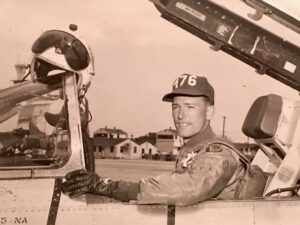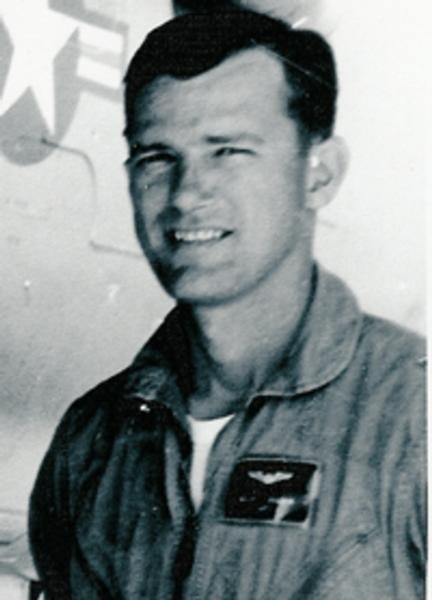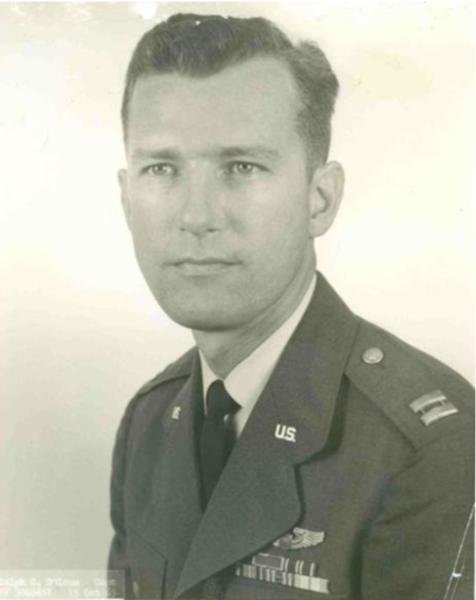Ralph Balcom, Jr. was the older brother of SSS Member Keith Balcom.
Captain Ralph Carol Balcom, who joined the U.S. Air Force from Washington, was a member of the 421st Tactical Fighter Squadron. “On May 15, 1966, he piloted an F-105D Thunderchief (tail number 61-0174) as the lead aircraft in a three-plane bombing mission over North Vietnam. The flight was unable to strike the primary target due to cloud cover and moved down the coast to bomb a section of Route 1A. After dropping his ordnance, Capt Balcom radioed that he would return to base, and he was last seen climbing through a cloud formation in Quang Binh Province.
The other two aircraft on the mission lost visual contact with Capt Balcom after they entered the cloud and they were unable to locate him after exiting. Immediate search and rescue efforts failed to locate Capt Balcom. Information from later investigations indicated that Capt Balcom’s aircraft was likely hit by enemy fire and crashed; however, he has not been recovered and remains unaccounted for. “(1) “Two months later a propaganda film appeared with a man Ralph’s parents immediately recognized as their son being paraded down the streets of Hanoi. The U.S. Government later identified the man as a returned POW Kyle Berg, also from the state of Washington.
While carried in the status of missing in action (MIA), the U.S. Air Force promoted Capt Balcom to the rank of Colonel (Col).
In November 1973, the Air Force discovered that Joint Casualty Resolution Center (JCRC) in Nakhon Phanom was carrying Balcom as a Prisoner of War while Defense Intelligence Agency carried him as Missing In Action. The Air Force directed JCRC to delete any reference pertaining to POW status in Balcom’s files. Balcom’s status was changed from Prisoner of War to Missing in Action, although analysts say today that JCRC records were the most accurate and complete because of their close proximity to the region.
JCRC also lists Balcom as being lost in Laos, not North Vietnam. The loss coordinates, 171200N 1064000E are in North Vietnam about 20 miles north of the DMZ. Grid coordinates XE100100 are located a few miles northwest of the Ban Karai Pass in Laos. It cannot be determined why there is a discrepancy in loss locations between agencies.”(2) Many people still wear his MIA/POW bracelet, especially his brother Keith who has it tattooed on his arm.
Today, over 20 years have passed since Ralph Balcom’s last flight over Vietnam. Ralph C. Balcom was promoted to the rank of Colonel during the period he was maintained as a Prisoner of War and Missing in Action. He is memorialized on the Courts of the Missing at the National Memorial Cemetery of the Pacific.
For a really good article about the Balcom brothers, see Issue 45 of The Intake.
Medley recently heard that Ralph’s dog tags have been discovered. For more about this recent find, see the article in the next issue of The Intake (No 46).
Sources: (1) https://www.pownetwork.org/bios/b/b075.htm; (2) text and photos from https://www.vvmf.org/Wall-of-Faces/2142/RALPH-C-BALCOM/
 “On 15 May 1966, then Captain Ralph C. Balcom was the pilot of the lead F105D (Serial #61-0174) in a flight of 5 conducting a morning armed reconnaissance mission over Quang Binh Province, North Vietnam. The mission area was known as Tally Ho and covered that section of North Vietnam bordered on the south by the demilitarized zone (DMZ), on the east by the coastline, on the west by the Laotian border, and on the north by an imaginary line drawn from the coast to the border 30 miles north of the DMZ.
“On 15 May 1966, then Captain Ralph C. Balcom was the pilot of the lead F105D (Serial #61-0174) in a flight of 5 conducting a morning armed reconnaissance mission over Quang Binh Province, North Vietnam. The mission area was known as Tally Ho and covered that section of North Vietnam bordered on the south by the demilitarized zone (DMZ), on the east by the coastline, on the west by the Laotian border, and on the north by an imaginary line drawn from the coast to the border 30 miles north of the DMZ.
When the flight arrived in the target area, Capt. Balcom established voice contact with the onsite Airborne Battlefield Command and Control Center (ABCCC) to obtain current mission data. Due to low cloud cover over the primary target, the AFCCC directed Capt Balcom to have his flight drop their ordnance on Route 1A, the primary road running north/south just inland from the coastline, south of the major city of Dong Hoi.
At 0950 hours, Ralph Balcom transmitted that he had dropped his bombs and was heading for home. Other flight members saw his aircraft climbing for altitude toward the west before disappearing into the clouds approximately 10 miles southwest of Dong Hoi. During the return flight to Korat, another pilot in the flight reported hearing an emergency beeper signal for a short time emanating from the ground below, but there was no indication of who initiated the signal.
When no further voice contact could be established with Capt. Balcom and his aircraft failed to return to base by the time his Thud’s fuel would have been exhausted, the flight leader was declared overdue. A large-scale search and rescue (SAR) mission was immediately initiated.
An electronic and visual search was conducted in and around the area west and southwest of Dong Hoi, but it failed to produce any sign of the flight leader or his aircraft. Likewise, none of the aircrews participating in the search heard the beeper signal reported being heard earlier in the day. At the time the formal search operation was terminated. Ralph Balcom was declared Missing in Action. At the same time Capt. Balcom was declared missing, the loss location was determined to be in the area where he was last seen as his aircraft climbed into the cloud cover southwest of Dong Hoi, North Vietnam.
On an unknown date sometime after the loss, US intelligence intercepted a least one Pathet Lao radio broadcast reporting the downing of an F-105 on 15 May 1966 in the sector west of the Ban Karai Pass. Capt. Balcom’s Thunderchief was the only F-105 lost on that date.
After Operation Homecoming in 1973, a team from the Joint Personnel Resolution Center (JPRC) reviewed Ralph Balcom’s casualty record. After a thorough examination of his record, they recommended a correction in the country of loss be made from North Vietnam to Laos. Part of the basis for this conclusion and correction was due to the Pathet Lao broadcast. Further, the broadcast indicated that the Thud was downed in the rugged jungle-covered mountains that were heavily infested with NVA troops approximately 6 miles northwest of Route 912, 8 miles southwest of the Lao/North Vietnamese border, 10 miles due west of the Ban Karai Pass and 41 miles west-southwest of Dong Hoi.”
Source: TogetherWeServed.com





